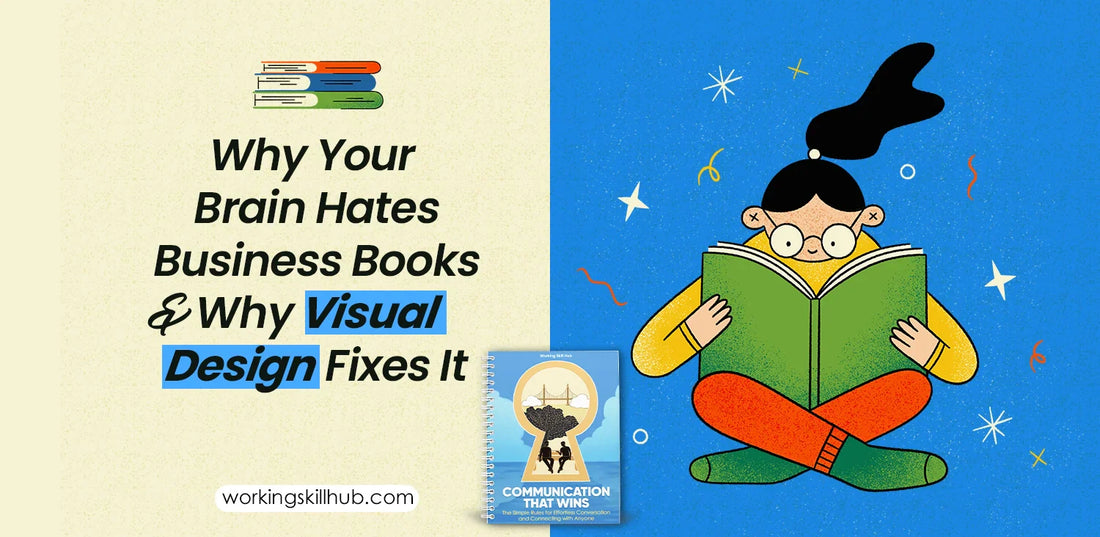It’s not that you’re a bad reader or lazy — your brain is optimized to avoid inefficient information. Long, dense business books built around pages of abstract prose clash with how modern brains assess value and learn. The solution isn’t more reading; it’s better design: drama, visualization, and deliberate sensory cues that match the brain’s natural processing.
1) The Brain’s 10-Second Filter: Why Non-Text Wins
Before you speak a word or turn a page, your brain is already judging whether something is worth attention. In real life and online, people make split-second decisions about value — and non-textual signals dominate that first impression.
What happens in those 10 seconds
-
Non-verbal dominance: Appearance, movement, and tone create the first story people tell themselves about you. Many communication models argue that non-verbal cues account for the majority of first-impression weight.
-
Subliminal bandwidth: During interactions, thousands of tiny sensory cues (posture, micro-expressions, pace) stream into the brain every second. The brain uses this fast sensory data to decide whether to invest effort in decoding words.
-
Result for text: A wall of words — a dense, unillustrated chapter — fails that filter. It signals “low immediate reward” and gets mentally shelved. The brain avoids extra cognitive work unless the payoff looks obvious from the start.
Practical implication: If your material doesn’t offer fast sensory payoff (visuals, clear layout, immediate examples), readers will switch to something that looks easier to process.
2) Why “Just Telling” Fails: Logic vs. Human Psychology
Good advice alone isn’t enough. Traditional business writing often assumes readers are rational machines who will accept facts and change behavior — but people carry ego, bias, and emotional wiring that block raw logic.
Three psychological barriers
-
Logic vs. ego: Facts that directly challenge someone’s beliefs or competence often feel like personal attacks. People protect self-image — so a purely logical correction can provoke resistance.
-
Facts aren’t vivid: A true statement is not the same as a memorable one. The brain prefers experiences — images, metaphors, and scenarios — that it can rehearse mentally. Dry statements don’t create those experiences.
-
Vagueness kills attention: If an idea remains abstract or complicated, the listener’s mind will wander to easier mental snacks. People invest effort only when the reward (clarity, usefulness, immediate next steps) is obvious.
Practical implication: To change behavior, communication must handle emotions and identity, not just present evidence. It must make the truth feel alive and actionable.
3) The Solution: Drama, Visualization, and Design
If words alone lose battles for attention, then combine them with design and sensory drama. Visual design is not decoration — it’s a cognitive tool that turns abstract advice into concrete, rehearsable behavior.
A. Demand the Drama — bring motion and intensity
-
What this means: Great speakers don’t only rely on sentences; they use gesture, pacing, and physical emphasis to make ideas feel consequential.
-
How design mimics that: Use dynamic layouts, motion (in digital formats), accent graphics, and staged reveals so the content “acts” rather than simply “says.” Drama signals importance and triggers attention systems.
B. Leverage Visualization — make the mind rehearse
-
Mental rehearsal is powerful: People learn faster when they “see” themselves doing something. Images, diagrams, and concrete analogies enable that rehearsal.
-
Techniques that work:
-
Vivid metaphors (visual analogies rather than abstract similes).
-
Step-by-step diagrams that show posture, sequencing, or flow.
-
Micro-stories and scenarios that let readers imagine concrete outcomes.
-
Callouts and annotated screenshots that highlight non-verbal cues like gaze or gesture.
-
C. Maximize Connection — polish for credibility and speed
-
First impressions matter: A messy, text-heavy handout communicates amateurism. Clean, purposeful visual design signals competence and respect for the reader’s time.
-
Design = courtesy: Tight hierarchy (headlines, subheads, bullets), clear summaries, and “scanable” pages let busy people decide quickly whether to invest attention. That respect builds trust and increases follow-through.
4) Converting Theory into Practice: What Visual Design Actually Does
Visual design bridges theory and execution by doing four concrete things:
-
Reduces cognitive friction — by chunking ideas visually (diagrams, lists, icons), it lowers the effort required to understand.
-
Makes ideas rehearsable — images and sequences let the reader mentally simulate actions before trying them.
-
Targets emotions and identity — visuals can honor the reader’s pride and identity (e.g., showing someone “like them” achieving the outcome) rather than attacking it.
-
Speeds decision signals — good design surfaces the payoff fast so the brain says, “This is worth my time.”
5) Practical Design Checklist (How to turn a chapter into usable learning)
If you want a business book, article, or presentation that the brain will actually use, apply these steps:
-
Start with the payoff: Lead each section with a one-line “what you get” statement (benefit first).
-
Use a visual headline: Replace dense headings with clear, benefit-driven headlines plus a 10-second visual (icon/thumbnail).
-
Break ideas into single-idea visual units: One idea per page or panel, with a diagram, quick example, and 1–2 action steps.
-
Add vivid analogies: Prefer visual metaphors that map to real sensory images.
-
Show the steps: For skills, include sequential visuals (before/after, do/avoid, posture examples).
-
Annotate non-verbal cues: Use images or small illustrations to call out posture, gaze, tone.
-
Include rehearsal prompts: Short exercises that ask the reader to imagine or act out the scene.
-
Make it scannable: Bullets, pull quotes, color highlights, and summary boxes for quick review.
-
Design for credibility: White space, consistent typography, and quality images signal professional care.
6) A Short Example (text → visual upgrade)
-
Text-only: “Be confident and smile more in meetings.”
-
Visual upgrade: A two-panel graphic: left panel shows slumped posture + three short bullets of negative micro-signals; right panel shows upright posture, “sticky eyes” (annotated), and a caption: “Practice steady breathing for 30s before speaking — inhale 4, hold 2, exhale 6; hold eye contact two seconds longer.”
Read Less, Design Better
Your brain isn’t failing you — the format is. Traditional business books ask readers to perform heavy mental work without offering the sensory cues or rehearsal opportunities the brain needs. If you want faster learning and higher impact, demand materials that are quick to scan, visually rich, and designed for mental rehearsal. Visual design isn’t a cosmetic upgrade — it’s the difference between forgetting a concept and actually using it.
If your learning tools look like tax returns, your brain will keep hunting for a better snack. Insist on design that makes ideas visible, tangible, and dramatically easy to act on.


